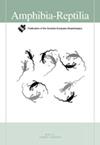Mass-related differences in metabolic rate and fasting endurance explain divergence in seasonal activity of Mediterranean lizards
IF 1.3
4区 生物学
Q3 ZOOLOGY
引用次数: 1
Abstract
We analysed the effects of body mass on the monthly activity patterns of six Mediterranean lacertid lizard taxa, four relatively small species, the Italian wall lizard (Podarcis siculus), the common wall lizard (Podarcis muralis), the blue-throated keeled lizard (Algyroides nigropunctatus), and the Ionian wall lizard (Podarcis ionicus), and two larger species, the western green lizard (Lacerta bilineata) and the Balkan green lizard (Lacerta trilineata). The highest number of observations for all six species occurred in April and May and the lowest in July and August, the latter being the hottest and driest months of the year. The two larger species were mainly active from March to July, whereas the four smaller species had an additional period of high activity from September to November. As all six species reproduce during spring, the increase in activity of the smaller species in autumn was consequently unrelated to reproductive behaviour. There was no difference in seasonal activity of the two smaller Italian species at sites with or without the larger green lizards. It is therefore unlikely that interference competition/predation by green lizards caused the increased autumnal activity of the smaller lizards. We suggest that due to their lower mass-specific metabolic rates, larger species can obtain sufficient lipid stores over a shorter annual activity to ensure successful reproduction the subsequent spring. By contrast, smaller species have greater need to replenish their lipid reserves after summer fasting and therefore resume much higher activity levels in September to November to attain this goal.代谢率和禁食耐力的质量相关差异解释了地中海蜥蜴季节性活动的差异
我们分析了体重对6个地中海壁虎类群的月活动模式的影响,其中4个相对较小的物种,意大利壁虎(Podarcis siculus)、普通壁虎(Podarcis muralis)、蓝喉龙骨蜥(Algyroides nigropunctatus)和爱奥尼亚壁虎(Podarcis ionicus),以及2个较大的物种,西部绿蜥(Lacerta bilineata)和巴尔干绿蜥(Lacerta trilineata)。4月和5月观测次数最多,7月和8月观测次数最少,7月和8月是一年中最热和最干燥的月份。2个较大的种主要在3 - 7月活跃,而4个较小的种在9 - 11月有额外的活跃期。由于所有6个物种都在春季繁殖,因此较小物种在秋季活动的增加与繁殖行为无关。在有或没有较大绿蜥蜴的地点,两种较小的意大利物种的季节活动没有差异。因此,绿蜥蜴的干扰竞争/捕食不太可能导致小蜥蜴的秋季活动增加。我们认为,由于它们较低的质量特定代谢率,较大的物种可以在较短的年度活动中获得足够的脂质储存,以确保随后的春季成功繁殖。相比之下,较小的物种在夏季禁食后更需要补充脂肪储备,因此在9月至11月恢复更高的活动水平以达到这一目标。
本文章由计算机程序翻译,如有差异,请以英文原文为准。
求助全文
约1分钟内获得全文
求助全文
来源期刊

Amphibia-Reptilia
生物-动物学
CiteScore
3.10
自引率
6.20%
发文量
39
审稿时长
6-12 weeks
期刊介绍:
Amphibia-Reptilia is a leading European multi-disciplinary journal devoted to most of the aspects of herpetology: ecology, behaviour, evolution, conservation, physiology, morphology, paleontology, genetics, and systematics.
Amphibia-Reptilia publishes high quality original papers, short-notes, reviews, book reviews and news of the Societas Europaea Herpetologica (SEH). The Societas Europaea Herpteologica (SEH) website is located at: www.seh-herpetology.org.
 求助内容:
求助内容: 应助结果提醒方式:
应助结果提醒方式:


